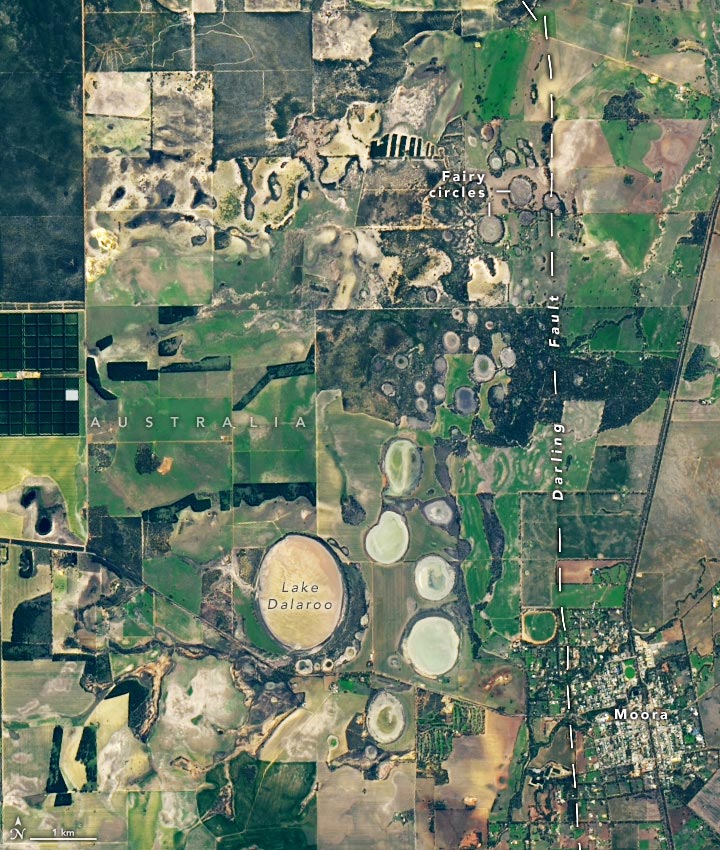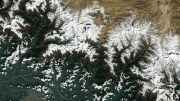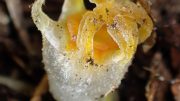
Satellite image of groups of fairy circles near the town of Moora, Australia, acquired on June 27, 2023, by the Operational Land Imager-2 (OLI-2) on Landsat 9. Australia’s “fairy circles” could be a natural source of clean hydrogen energy, but further research is needed to understand and utilize them effectively.
Circular Depressions Seep Hydrogen Gas
Naturally occurring hydrogen was discovered emanating from “fairy circles” in Australia.
Pockmarked landscapes in Australia may be a treasure map of sorts for a natural source of clean energy. Clusters of so-called “fairy circles” in the North Perth Basin of Western Australia have been found to seep hydrogen gas from their perimeters. Natural sources of hydrogen such as these, which have been found on multiple continents, are receiving more and more attention in the quest for fossil fuel alternatives.
Landsat 9’s Observation
This image shows groups of fairy circles near the town of Moora, about 150 kilometers (90 miles) north of Perth. It was acquired by Landsat 9’s Operational Land Imager-2 (OLI-2) on June 27, 2023. In this area, groups of round depressions are found along the north-south-trending Darling Fault. Sometimes called salt lakes, the features seen here are several hundred meters in diameter, and the amount of vegetation and water contained in their interiors changes over time.
Scientific Investigations and Findings
In 2021, scientists took soil-gas measurements in and around some of these circles. They found that hydrogen was present in the soil, with elevated concentrations in soil around the circles’ edges. The study, led by Emanuelle Frery of Australia’s Commonwealth Scientific and Industrial Research Organisation (CSIRO), was the first to confirm natural hydrogen seeps in Australia and link them to the region’s geology. However, the relationships between the presence of hydrogen, circular features, and vegetation patterns are not well understood, Frery said.
Hydrogen can be produced naturally in the Earth’s subsurface by a number of processes, including certain water-rock reactions and radiation-driven breakdown of water molecules (radiolysis). The North Perth Basin has some of the conditions conducive to hydrogen production. The study’s authors hypothesized that the hydrogen forms when water reacts with the area’s iron-rich rocks. After looking at geophysical data, they think that the fault zone may offer vertical pathways for the gas to migrate up to the surface.
Historical Discoveries and Growing Interest
Historically, hydrogen reservoirs have tended to be discovered by accident. In one example, well diggers in Mali in the late 1980s tapped into what was later determined to be a highly concentrated store of natural hydrogen. Now, satellite imagery readily reveals fairy circles that might be investigated as potential seeps. Other semi-circular to circular surface features with high concentrations of hydrogen in their soil have been documented around the world, from Brazil to Russia to the U.S. state of North Carolina. Experts suspect that there are many more natural sources of hydrogen to be found, given the proper tools and the will to look.
In Australia and beyond, interest in hydrogen as a zero-emission fuel is growing. Currently, commercial hydrogen must be produced using energy-intensive processes such as separating water into hydrogen and oxygen with an electric current, or isolating hydrogen from fossil fuel feedstocks. Some argue that natural sources offer a viable alternative. However, much remains to be learned about how and where hydrogen forms beneath the surface, and how best to extract and store it.
NASA Earth Observatory image by Wanmei Liang, using Landsat data from the U.S. Geological Survey and fault lines from the Government of Western Australia.









Having measurable quantities of hydrogen in the soil is not the same thing as having a concentration sufficiently high to justify building an infrastructure to capture it and transport it to where it can be used. Just what is meant by “elevated concentrations?” Once again, something that is called science is missing the numbers that defines science.
Yesterday US Department of Energy ARPA-E launched $20 million to Explore Potential of Geological Hydrogen, two initiatives Exploratory Topic G: Production of Geologic Hydrogen Through Stimulated Mineralogical Processes, this is Orange Hydrogen stimulating the production of hydrogen in the earth e.g. by pumping hot water into iron rich rocks and Exploratory Topic H: Subsurface Engineering for Hydrogen Reservoir Management this is natural White/Gold Hydrogen, there was also articles yesterday on nat hydrogen in Forbes, Reuters and Science magazine, the latters Hidden Hydrogen by Eric Hand is the best article I have read on this subject. July Koloma raised $91 million from five investors including Bill Gates Breakthrough Energy, the firm uses AI and satellite images to pinpoint hydrogen and will pump hydrogen from wells in Midwest USA. Hy Terra Ltd found hydrogen in two wells in Nemaha Ridge Kansas and has just double the exploration area to 9,025 km and tested the Hoarty NE3 in Geneva Nebraska with partner Natural Hydrogen Energy LLC.
Again, where are the numbers on the abundance, concentration, and the reserves of the natural hydrogen? A single gold nugget does not make a gold mine, nor is the investment in infrastructure warranted unless unless the exploration reveals reserves sufficient to balance the costs of the investment. If the hydrogen is only a few parts per million, then energy will have to be expended to purify it. That translates to a lower net gain in energy.
Your citations sound like the blind faith of a deer hunter who has observed scat on the ground (perhaps from a buck passing through his hunting area) but has not actually seen any deer.
Bill Gates has so much money that I don’t think that his judgement on returns on investment is sound investing advice. Do you think that he will miss a few million dollars that he doesn’t really know what to do with if the investment proves to be a bust? Bill Gates is not an entrepreneurial genius. He is someone who just happened to be in the right place at the right time. Gary A. Kildall had a prior commitment when IBM wanted to meet with him, but Gates made himself available. A decision that has probably haunted Kildall ever since.
I don’t care what color one ‘paints’ hydrogen. The first barrier is to be able to produce it at a profit, in the quantities needed to replace energy-dense fossil fuels. The next problem (not in that order) is how to handle all the water vapor released in cities from the combustion and fuel-cell oxidation of hydrogen brought in from the countryside.